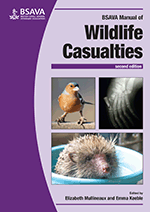
Full text loading...

The coastlines of Britain and Ireland provide the most important breeding sites for seabirds in the northeast Atlantic Ocean and 25 species breed here regularly. Presentations include: trauma, such as fractures, and fishing hook and line entanglement injuries; poisoning, such as botulism, and the effects of oiling; and various infectious diseases. This chapter covers: ecology and biology; anatomy and physiology; capture, handling and transportation; clinical assessment; first aid and hospitalization; anaesthesia and analgesia; specific conditions; therapeutics; husbandry; rearing of juvenile seabirds; rehabilitation and release; and legal considerations.
Seabirds, Page 1 of 1
< Previous page | Next page > /docserver/preview/fulltext/10.22233/9781910443316/9781910443316.24-1.gif

Full text loading...


















